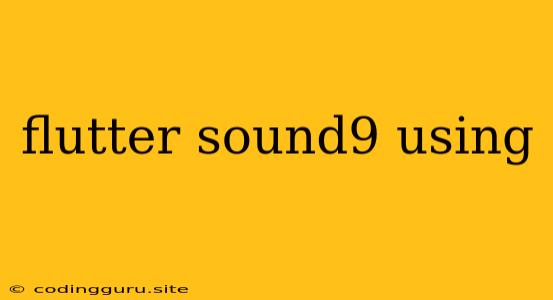Flutter Sound: A Comprehensive Guide to Adding Sound to Your Flutter App
Flutter, known for its beautiful UI and cross-platform capabilities, empowers developers to create stunning and engaging applications. But what if you want to enhance the user experience by incorporating sounds? This is where Flutter Sound comes in.
Flutter Sound is a robust and versatile package that simplifies the process of adding sound effects, music, and audio recording functionality to your Flutter applications. It's a powerful tool for developers of all skill levels, making audio integration a breeze.
Why Choose Flutter Sound?
Flutter Sound stands out from other audio libraries due to its extensive features and user-friendly API. Here are some key benefits:
- Cross-Platform Support: Flutter Sound works flawlessly across Android, iOS, Linux, Windows, and macOS, ensuring your app reaches a wider audience.
- Rich Functionality: From playing audio files to recording audio, Flutter Sound provides a comprehensive set of features for all your audio needs.
- Simplified API: The library's intuitive API makes it easy to implement audio features in your app without complex code.
- Performance Optimization: Flutter Sound is carefully optimized to provide smooth playback and recording experiences, even on devices with limited resources.
Getting Started with Flutter Sound
- Add the Package: Begin by adding the
flutter_soundpackage to yourpubspec.yamlfile:
dependencies:
flutter_sound: ^x.x.x
Replace x.x.x with the latest version of the Flutter Sound package. Then run flutter pub get to fetch the package.
- Import the Library: In your Dart file, import the Flutter Sound library:
import 'package:flutter_sound/flutter_sound.dart';
- Initialization: Before using the library, initialize the Flutter Sound instance:
FlutterSoundPlayer _player = FlutterSoundPlayer();
- Audio Playback: To play an audio file, use the
startPlayermethod:
await _player.startPlayer(
fromUri: Uri.file("path/to/audio.mp3"),
whenFinished: () {
// Handle audio playback completion
}
);
Advanced Features of Flutter Sound
Flutter Sound offers a variety of advanced features to take your audio integration to the next level:
- Audio Recording: Record high-quality audio using the
startRecordermethod:
await _recorder.startRecorder(
toFile: "path/to/recording.wav",
codec: Codec.pcm16bit,
sampleRate: 44100,
bitRate: 128000,
numberOfChannels: 2
);
- Audio Effects: Apply effects like equalization, reverb, and pitch shifting to enhance the audio experience:
await _player.setVolume(0.5); // Adjust volume
await _player.setSpeed(1.2); // Adjust playback speed
- Audio Visualization: Create dynamic audio visualizations to engage users with your app:
_player.onProgress.listen((event) {
// Update your visualization based on the audio progress
});
- Background Audio: Continue playing audio even when your app is in the background:
await _player.startPlayer(
fromUri: Uri.file("path/to/audio.mp3"),
whenFinished: () {
// Handle audio playback completion
},
isLooping: true, // Enable looping for continuous playback
audioFocus: true // Request audio focus for background playback
);
Tips for Using Flutter Sound
- Handle Permissions: For audio recording, request the necessary permissions from the user.
- Manage Audio Focus: When playing audio, request audio focus to avoid interference from other apps.
- Optimize Performance: Use appropriate audio codecs and sample rates for efficient audio playback and recording.
- Consider Error Handling: Implement error handling to gracefully handle unexpected situations.
Example: Creating a Simple Audio Player
import 'package:flutter/material.dart';
import 'package:flutter_sound/flutter_sound.dart';
class AudioPlayerApp extends StatefulWidget {
@override
_AudioPlayerAppState createState() => _AudioPlayerAppState();
}
class _AudioPlayerAppState extends State {
FlutterSoundPlayer _player = FlutterSoundPlayer();
bool _isPlaying = false;
@override
void initState() {
super.initState();
_initPlayer();
}
Future _initPlayer() async {
await _player.initialize();
}
Future _playAudio() async {
await _player.startPlayer(
fromUri: Uri.file("path/to/audio.mp3"),
whenFinished: () {
setState(() {
_isPlaying = false;
});
}
);
setState(() {
_isPlaying = true;
});
}
Future _stopAudio() async {
await _player.stopPlayer();
setState(() {
_isPlaying = false;
});
}
@override
Widget build(BuildContext context) {
return Scaffold(
appBar: AppBar(
title: Text("Audio Player"),
),
body: Center(
child: Column(
mainAxisAlignment: MainAxisAlignment.center,
children: [
ElevatedButton(
onPressed: _isPlaying ? _stopAudio : _playAudio,
child: Text(_isPlaying ? "Stop" : "Play"),
),
],
),
),
);
}
@override
void dispose() {
_player.release();
super.dispose();
}
}
Conclusion
Flutter Sound is an invaluable tool for developers seeking to incorporate audio into their Flutter applications. Its ease of use, rich functionality, and cross-platform compatibility make it an excellent choice for projects of any scale. Whether you're adding sound effects, playing music, or recording audio, Flutter Sound has you covered. Start exploring the possibilities today and enhance your Flutter apps with the power of sound!
